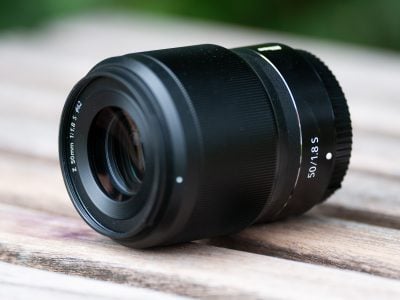Nikon Z 50mm f1.8S review
-
-
Written by Thomas
Quality
Testing: Longitudinal Chromatic Aberration and focus shift
Lenses with focal ratios of f2.8 or larger are often prone to longitudinal color aberrations (loCA, a.k.a. “axial color” or “bokeh CA”). These show up as magenta coloration in the foreground and greenish hues in the background and are not easily corrected in post-processing. The new Nikon fortunately only shows very little loCA from f1.8 to f2.8 which is comparable to the very good Zeiss Otus (see below).
Nikon Z 50mm f1.8 S Longitudinal Chromatic Aberration (loCA)
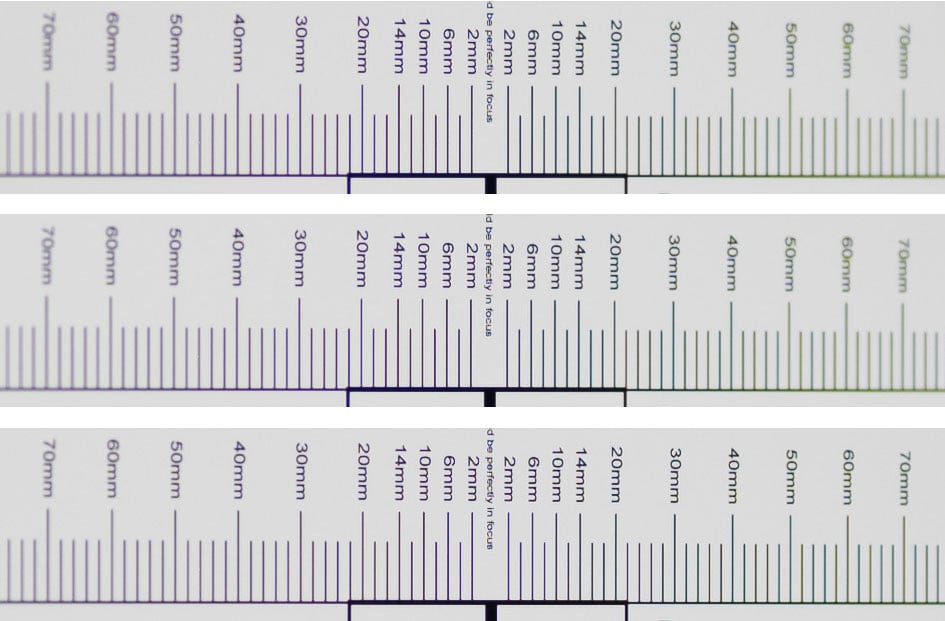
100% crops, from top to bottom: f1.8, f2.0, f2.8; left = foreground, right = background
The test also revealed that there is no focus shift to speak of at distances of 2m and farther away although the background sharpens up faster than the foreground when the lens is stopped down. At magnifications larger than 1:10 the lens shows clear focus shift between f1.8 and f5.6 but that is avoided by the camera focusing while stopped down to shooting aperture.
The same test with the Zeiss 55mm f1.4 Otus shows that even a lens designated “apochromatic” can still show some loCA:
Zeiss 55mm f1.4 Otus Longitudinal Chromatic Aberration (loCA)
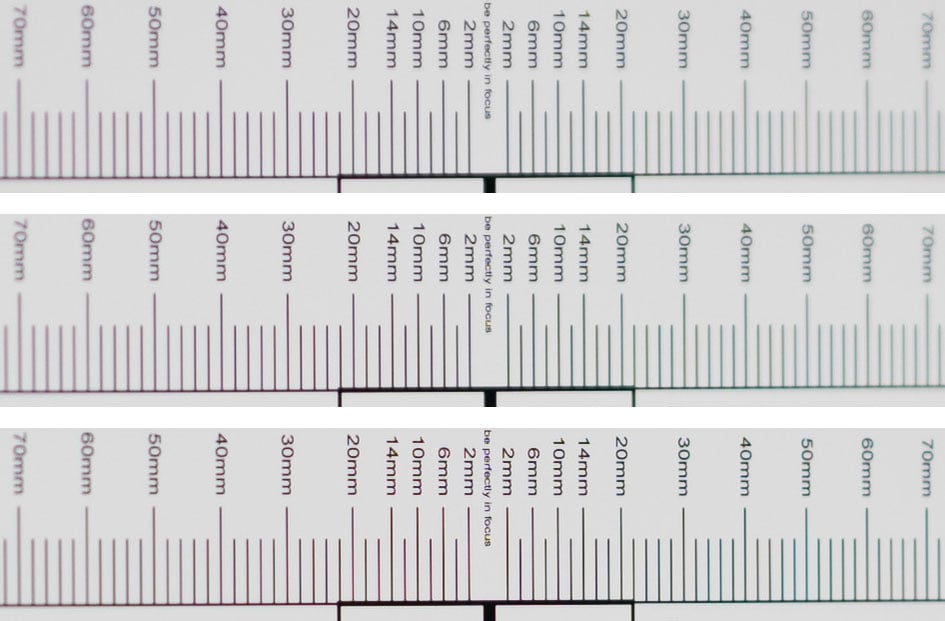
100% crops, from top to bottom: f1.4, f2.0, f2.8; left = foreground, right = background
Longitudinal CAs show up prominently when shooting fine structures against a very bright background like in the following shots:

Above: Nikon Z 50mm f1.8 S at f1.8, 50% crop

Above: Zeiss 55mm f1.4 Otus at f1.8, 50% crop

Above: Nikon 50mm f1.4G at f1.8, 50% crop
The Z Nikkor retains the highest contrast in this situation and produces only little colorful “ghosting” indicating that it might have even less loCA than the Otus. While the Nikon 50mm f1.4G is clearly the least well corrected lens in this comparison.
Sharpness and contrast
Let’s have a look at the theoretical performance of the new Nikon Z 50mm f1.8S and compare it to the performance of the Nikon 50mm f1.8G, 50mm f1.4G, and the Zeiss 55mm f1.4 Otus:
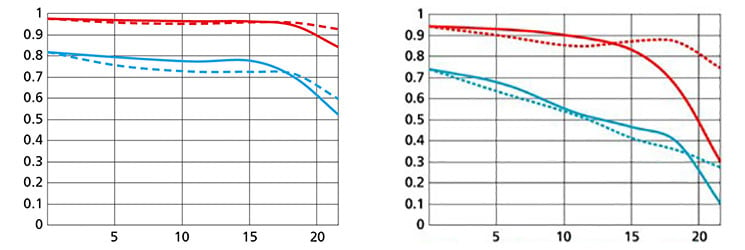
Above: MTF Nikon Z 50mm f1.8 S (left), Nikon 50mm f1.8G (right) at f1.8
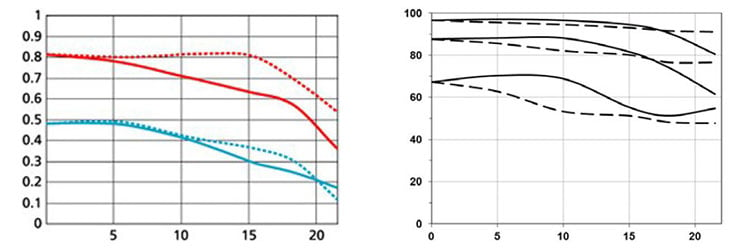
Above: MTF Nikon 50mm f1.4G (left), Zeiss 55mm f1.4 Otus (right) at f1.4
These MTF charts of the Nikon lenses show the computed lens-performance wide open without influence of diffraction. Higher values are better (more contrast) and the closer the line-pairs are together the less astigmatism (= resolution depends on the orientation of the test-pattern) the lens has. The x-axis displays the distance from the optical axis (=center of the sensor) in mm. I’ll show you the real-life performance at 4 mm (center), 13 mm (APS-C/DX-corner), and 20 mm (FF/FX-corner) on a 45MP Nikon Z7 body.
While Nikon displays the contrast-curves at 10 line-pairs/mm (in red) and 30 lp/mm (in blue) Zeiss displays the measured contrast-curve (which includes the effects from diffraction) at 10, 20 and 40 lp/mm (from top to bottom), which is a bit unusual.
From the charts the new Nikon Z 50mm f1.8S should have a clear advantage over the older Nikon 50mm f1.8G and 1.4G. The new Z Nikkor even looks as good as the Zeiss Otus but keep in mind that the Nikon is at f1.8 here.
Let’s see how this theoretical performance of Nikon’s new Z Nikkor translates into real life results in the sharpness test based on Siemens-stars. Processing was done in Lightroom 8/CRAW 11 from RAW to Adobe Color profile with the built-in lens profile applied. Noise-reduction is set to 0, sharpening to 50/0.5/36/10, with no extra tone, color, or saturation adjustment. White-balance was adjusted to a neutral white and I did some exposure compensation to make the brightness of all crops match. So you will not see light fall-off in the corners. Removal of lateral color aberrations is ON, longitudinal CA are not corrected.
The following 100% crops show the new Nikon Z 50mm f1.8 S from f1.8 down to f11 compared to the Zeiss 55mm f1.4 Otus and the Nikon 50mm f1.4G at f1.8 and f4.0 plus the Nikon Z 24-70mm f4 S at f4.0. No lens profiles were applied to the Zeiss Otus and the Nikon 50mm f1.4G.
Nikon Z 50mm f1.8S; 100% crop from center, APS-C/DX-corner, FF/FX-corner

Above: Nikon Z 50mm f1.8 S at f1.8

Above: Zeiss 55mm f1.4 Otus at f1.8; also available at f1.4, f1.6, f2.0, f2.8, f4.0, f5.6, f8.0, f11

Above: Nikon 50mm f1.4G at f1.8; also available at f1.4, f1.6, f2.0, f2.8, f4.0, f5.6, f8.0, f11
At f1.8 the Nikon Z 50mm f1.8S holds it own against the reference Otus lens with a slightly sharper center and a slightly softer FX-corner. But the Z Nikkor shows more field-curvature at this distance than the Zeiss Otus. The older Nikon 50mm f1.4G is not bad but is clearly the softest lens in this comparison.
Here’s the results from two other lenses I had tested on a 36MP Nikon D800/D810 (sharpening adapted accordingly):

Above: Tamron 45mm f1.8 VC on a D810 at f1.8

Above: Sigma 50mm f1.4 Art on a D800 at f1.8
The 13% lower linear resolution of the 36MP body is a little less taxing on the lenses but they are still not as sharp as the new Z Nikkor.
Now let’s see how the new Z Nikkor develops when stopped down:

Above: Nikon Z 50mm f1.8 S at f2.0

Above: Nikon Z 50mm f1.8 S at f2.8

Above: Nikon Z 50mm f1.8 S at f4.0

Above: Zeiss 55mm f1.4 Otus at f4.0

Above: Nikon 50mm f1.4G at f4.0

Above: Nikon Z 24-70mm f4 S at 49mm, f4.0; also available at f5.6, f8.0, f11
The new Nikon Z 50mm f1.8 S and the Zeiss Otus stay very close with the Otus having a slightly sharper DX- and FX-corner. The older Nikon 50mm f1.4G has now sharpened up nicely but is still trailing the other two prime lenses. And the new entry in this comparison, the Nikon Z 24-70mm f4S zoom lens, proves it’s worth against the primes with very respectable performance – although the FX-corner is the softest of the four.

Above: Nikon Z 50mm f1.8 S at f5.6

Above: Nikon Z 50mm f1.8 S at f8.0

Above: Nikon Z 50mm f1.8 S at f11
Overall Nikon’s new Z 50mm f1.8S lens proves its merit in this test against my reference lens in this class, the Zeiss 55mm f1.4 Otus. The Z Nikkor is very close in performance to the Otus and bests all other standard lenses I’ve tested so far.
Performance at long distances
The Siemens-star test-targets are shot at a distance of 45x focal length (i.e. at around 2.3m for 50mm focal length). But performance of lenses also depends on the shooting distance. Therefore I present another series of test-shots of a city around 1 km away. Processing was done in Lightroom 8/CRAW 11 from RAW to Adobe Color profile with the lens-profile for distortion applied, vignette control was off. Noise-reduction is set to 0, sharpening to 50/0.5/36/10, with no extra tone, color, or saturation adjustment. I used autofocus at the largest aperture and did not change focus for other apertures. All shots were made at ISO 64 and VR switched off.
The main image shows the complete scene wide open to give you an impression of the angle of view and to judge vignetting. You can access the respective shots up to f11 via the links beneath the main image. Following the main image are 100% crops from the new Nikon Z 50mm f1.8 S down to f11 compared to the Zeiss 55mm f1.4 Otus plus Nikon 50mm f1.4G at f1.8 and f4.0 and the Nikon Z 24-70mm f4 S at 50mm, f4.0. The prime lenses were shot on the same day only minutes apart. The zoom was shot another day under similar atmospheric conditions. Please respect our copyright and only use those images for personal use.
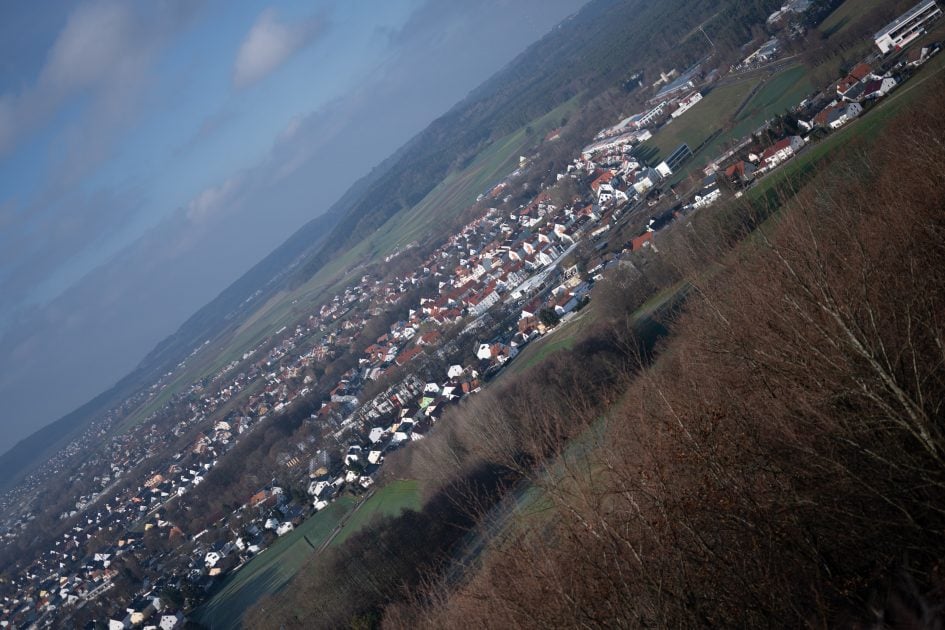
Above: Nikon Z 50mm f1.8 S at f1.8; click image to access original at Flickr; also available at f2.0, f2.8, f4.0, f5.6, f8.0, f11

Above: Nikon Z 50mm f1.8 S at f1.8

Above: Zeiss 55mm f1.4 Otus at f1.8; also available at f1.4, f1.6, f2.0, f2.8, f4.0, f5.6, f8.0, f11

Above: Nikon 50mm f1.4G at f1.8; also available at f1.4, f1.6, f2.0, f2.8, f4.0, f5.6, f8.0, f11
The Nikon Z 50mm f1.8S looks sharper than the Zeiss Otus in the DX-corner. Impressive! Let’s see how the new Z Nikkor develops when stopped down:

Above: Nikon Z 50mm f1.8 S at f2.0

Above: Nikon Z 50mm f1.8 S at f2.8

Above: Nikon Z 50mm f1.8 S at f4.0

Above: Zeiss 55mm f1.4 Otus at f4.0

Above: Nikon 50mm f1.4G at f4.0

Above: Nikon Z 24-70mm f4.0 S at 50mm, f4.0; also available at f5.6, f8.0, f11
The new Nikon Z 50mm f1.8S is sharper in the center but a little softer in the FF-corner than the Zeiss Otus. The Nikon 50mm f1.4G has sharpened up nicely although it’s still a bit soft in the extreme corner. And the Nikon Z 24-70mm f4S zoom lens holds up quite well in this comparison.

Above: Nikon Z 50mm f1.8 S at f5.6

Above: Nikon Z 50mm f1.8 S at f8.0

Above: Nikon Z 50mm f1.8 S at f11
The new Nikon Z 50mm f1.8S repeats its very good performance in this long-distance test and can hold its own against the Zeiss Otus.
Vignetting and distortions
Vignetting and distortions are lens aberrations that can be easily corrected by software. Lightroom (LR) and Photoshop (PS) have offered lens profiles for some time which could be applied as an option. But with the Z series, like most mirrorless systems, Adobe applies lens profiles automatically whether you want them or not. You can select the degree of Vignette Control in camera between High, Normal, Low, and Off – which is then also applied by LR and PS to the RAW files – without the option to change the setting. But in Nikon’s own free Capture NX-D software (V1.5.0) the degree of Vignette Control can be changed. Auto Distortion Control can also be enabled or disabled in camera and in Capture NX-D – but not in LR or PS where it’s always turned On. Interestingly, this is not true for the Nikon Z 24-70mm f4S which does not allow to switch off Auto Distortion Control – neither in camera nor in Capture NX-D. The Nikon Z7 reference manual simply notes “that Off may not be available with some lenses”.
To make it easier to see light fall-off in the corners of a full-frame sensor I’ve arranged a series of shots with the new Z Nikkor at different apertures. All images were developed to the same brightness in the center and the lens profile applied, Vignette Control (VC) in camera was switched off (first row) or set to Normal (second row):
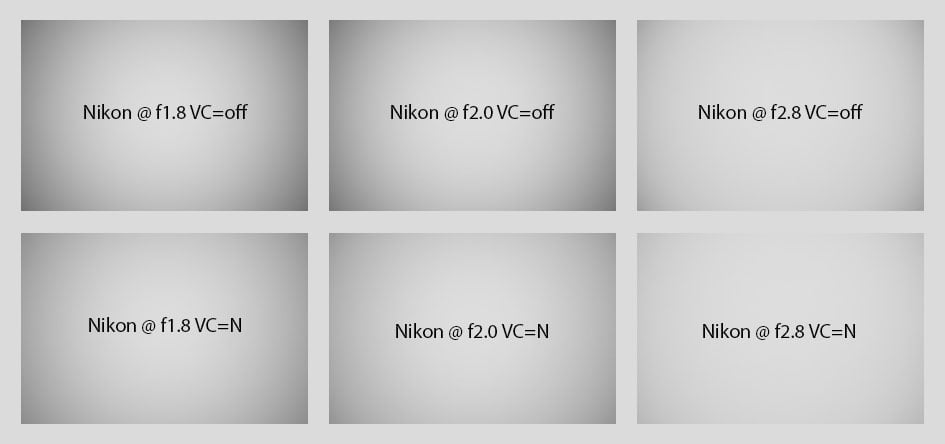
Above: Nikon Z 50mm f1.8 S at f1.8, f2.0, f2.8
The sample images above show that with the lens profile set to normal vignetting remains visible until f2.8. See the Zeiss 55mm f1.4 Otus with the Adobe lens profile applied (second row) in comparison:
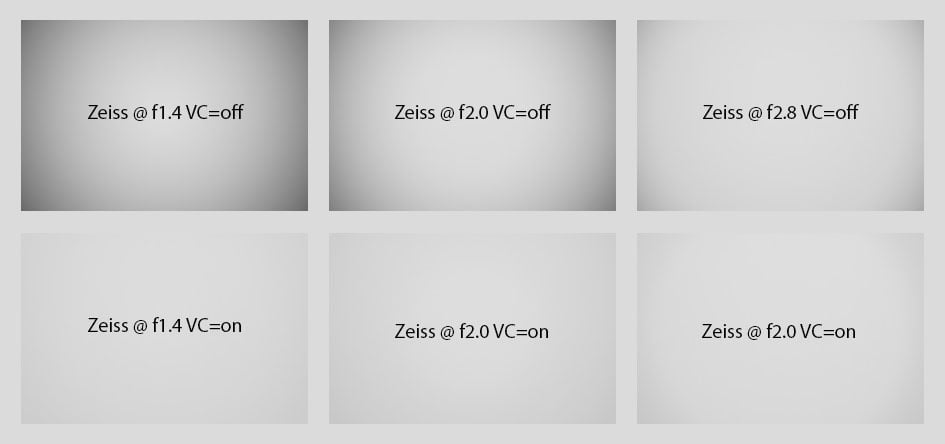
Above: Zeiss 55mm f1.4 Otus at f1.4, f2.0, f2.8
Adobe goes for a much stronger vignette compensation with the Zeiss Otus than Nikon does with its Z Nikkor.
Distortions of the new Z 50mm f1.8S are very well-corrected through Nikon’s lens profile as you can see in the examples at the end of the samples page. And if you wonder whether distortion control leads to a slight loss of resolution as pixels in the processed file have been wrangled to some degree and no longer exactly match the pixels on the sensor here’s the comparison:

Above: Nikon Z 50mm f1.8 S at f5.6, 100% crop from FF/FX-corner, left: Distortion Control=on, right: Distortion Control=off
I can’t find any discernible differences in sharpness between both crops.
Rendering of point-light sources at night-shots
Night-shots pose a different challenge for lenses as the contrast is even higher than under bright sun and point-light sources can reveal some weaknesses such as coma, haloing and colour-aberrations that do not show up as prominently in other test-shots. The 100% crops below the main image show the effect of coma in the FF/FX-corner of the new Z Nikkor and the Zeiss 55mm f1.4 Otus at various apertures:
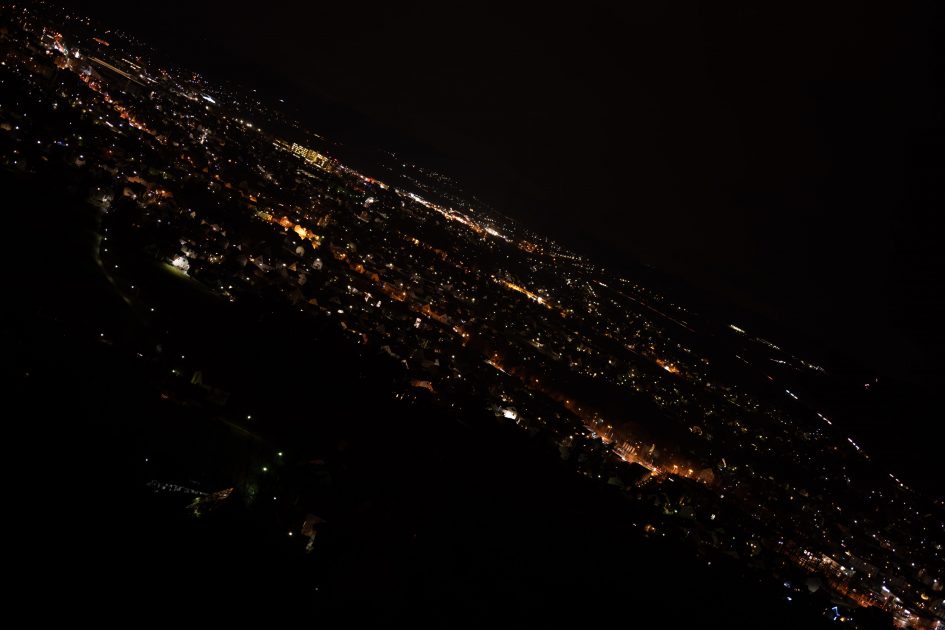
Above: Nikon Z 50mm f1.8 S at f1.8; click image to access original at Flickr; also available at f2.0, f2.8, f4.0, f5.6, f8.0

Above: Nikon Z 50mm f1.8 S; 100% crops from the FF/FX-corner at f1.8 (left), f2.8 (middle), f4.0 (right)

Above: Zeiss 55mm f1.4 Otus; 100% crops from the FF/FX-corner at f1.8 (left), f2.8 (middle), f4.0 (right)

Above: Nikon 50mm f1.4G; 100% crops from the FF/FX-corner at f1.8 (left), f2.8 (middle), f4.0 (right)
The new Nikon Z 50mm f1.8S has only little coma wide open like the Zeiss 55mm f1.4 Otus. Have a look at the Nikon 50mm f1.4G to see a classical example of very strong coma.
Rendering of out-of-focus point-light sources
This test is for the rendering of point-light sources in an out-of-focus background. The circle of confusion that is produced by this test is pretty indicative of Bokeh performance (in the background) and light fall-off. Ideally the out-of-focus image of the point-light is evenly lit and perfectly circular, with no “onion-rings”, and without coloration. Large aperture lenses normally produce an effect known as “cat’s eye” the further away from the optical axis the point-light is projected. This is due to optical vignetting in the lens barrel when light enters the lens from an angle.
The new Z Nikkor is first, followed by the Zeiss 55mm f1.4 Otus and the Nikon 50mm f1.4G.
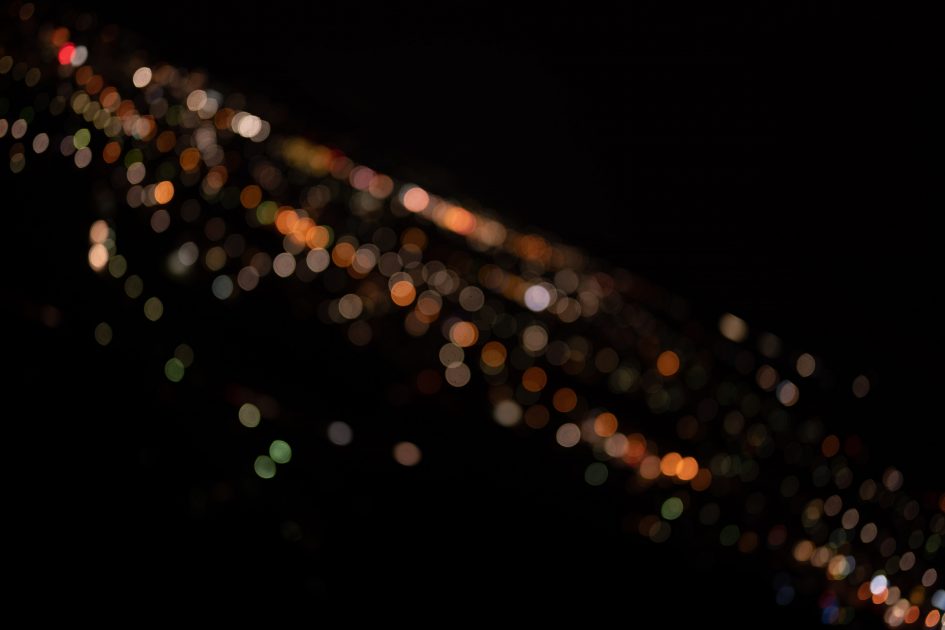
Above: Nikon Z 50mm f1.8 S at f1.8; click image to access original at Flickr; also available at f2.0, f2.8, f4.0, f5.6, f8.0

Above: Nikon Z 50mm f1.8 S at f1.8; 44% crops from center, DX-corner, FX-corner

Above: Zeiss 55mm f1.4 Otus at f1.4; 44% crops from center, DX-corner, FX-corner; also available at f1.8, f2.0, f2.8, f4.0, f5.6, f8.0

Above: Nikon 50mm f1.4G at f1.4; 44% crops from center, DX-corner, FX-corner; also available at f1.8, f2.0, f2.8, f4.0, f5.6, f8.0
The diameter of the Bokeh balls in the center is determined by the entrance pupil of the lens. So it’s no surprise that at their respective largest aperture the Zeiss Otus wins with its 10% longer focal length followed by the Nikon 50mm f1.4G and the 50mm f1.8 Z Nikkor last. The test also reveals that you should keep the rear lens element clean as the spots in the left crop from the Z Nikkor can attest to. Outlining is weakest from the Z 50mm f1.8S followed by the Zeiss Otus and the Nikon 50mm f1.4G. Texture within the circle is softest with the 50mm f1.4G while the Z Nikkor shows some clear texture although not as strong onion rings. Bokeh balls of all three lenses are already slightly compressed at the DX-corner where the Zeiss Otus retains the larger Bokeh balls.
Now let’s see how this analysis of out-of-focus point-light sources translates into Bokeh-performance shooting a book-shelf.
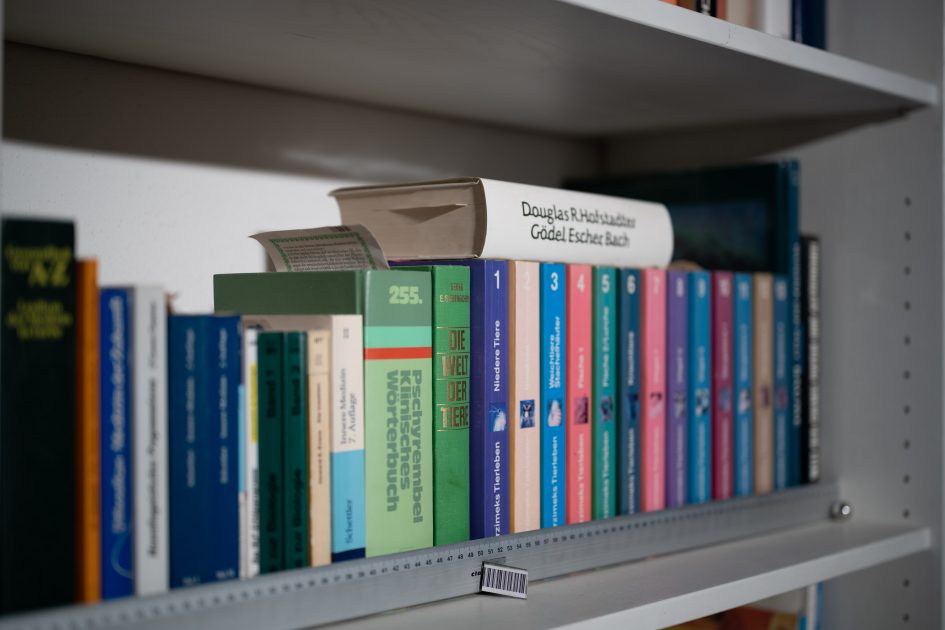
Above: Nikon Z 50mm f1.8 S at f1.8; click image to access original at Flickr; also available at f2.0, f2.8, f4.0, f5.6

Above: Nikon Z 50mm f1.8 S at f1.8; 44% crops from foreground, middle-ground, background

Above: Zeiss 55mm f1.4 Otus at f1.4; 44% crops from foreground, middle-ground, background; also available at f1.8, f2.0, f2.8, f4.0, f5.6

Above: Nikon 50mm f1.4G at f1.4; 44% crops from foreground, middle-ground, background; also available at f1.8, f2.0, f2.8, f4.0, f5.6
Both the Z Nikkor and the Zeiss Otus perform pretty comparable wide open although the Otus was shot at f1.4. The Nikon 50mm f1.4G suffers from a nervous background and longitudinal CA creating greenish coloration in the transition zone.
Portrait performance
50mm focal length may not be the classical choice for portraits on a full-frame camera but the Nikon Z 50mm f1.8 S can well be used for upper body or full body shots or offers an angle of view equivalent to a 75mm lens on a cropped DX sensor. And the background blur at closer shooting distances is nice enough to give it a try. All shots were done from the same position/distance so perspective does not change between shots. But due to the slightly different focal lengths of the lenses the images and crops show a little different framing and magnification. There are also some slight focus-differences which inevitably occur when you shoot a living, breathing subject.

Above: Nikon Z 50mm f1.8 S at f1.8; click image for 4k version, also available as large original at f1.8, f2.0, f2.8

Above: Nikon Z 50mm f1.8 S at f1.8, 50% crop; click image to view 100% crop

Above: Sigma 50mm f1.4 Art at f1.4, 50% crop; click image to view 100% crop, also available as large original at f1.4, f1.8, f2.0, f2.8

Above: Zeiss Otus 55mm f1.4 at f1.4, 50% crop; click image to view 100% crop, also available as large original at f1.4, f1.8, f2.0, f2.8
Background blur is the nicest from the Zeiss Otus which also produces a very smooth transition in the model’s hair. Second is the Sigma 50mm f1.4 Art followed by the Nikon Z 50mm f1.8 S.
Close-up performance
The Z 50mm f1.8 S goes down to 1:6 magnification which is less than from the Z 35mm f1.8 S (1:4.8) or the Z 24-70mm f4.0 S (1:3.1). Its performance in close-up shooting is not bad but nothing to write home about. The following image was shot at 1:6.6 magnification where the area of sharp focus is just 160 x 240mm. The crops shown below are from the center, 9mm, and 18mm off the center of the sensor respectively:

Above: Nikon Z 50mm f1.8 S at f1.8, 1:6.6 magnification; 100% crops

Above: Nikon Z 50mm f1.8 S at f4.0, 1:6.6 magnification; 100% crops

Above: Nikon Z 50mm f1.8 S at f8.0, 1:6.6 magnification; 100% crops
If you want sharp close-ups you better stop the new Z Nikkor down to f8.0. The Nikon Z 24-70mm f4.0S and especially the Z 35mm f1.8S perform much better in comparison.
Flare, glare, ghosting, and sun-stars
Catching a strong light-source shining directly into the lens is always a risky business: it could produce strange colorful ghost-images or reduce contrast considerably through flare and glare. The appearance of flare and ghosting depends on factors like the aperture and the angle of the light hitting the lens. So to judge the proclivity of the new Nikon Z 50mm f1.8 S for these artifacts I went through a series of well calculated shots against a strong light source to provoke glare and ghosting. See an examples at f11 where the effects are most obvious:
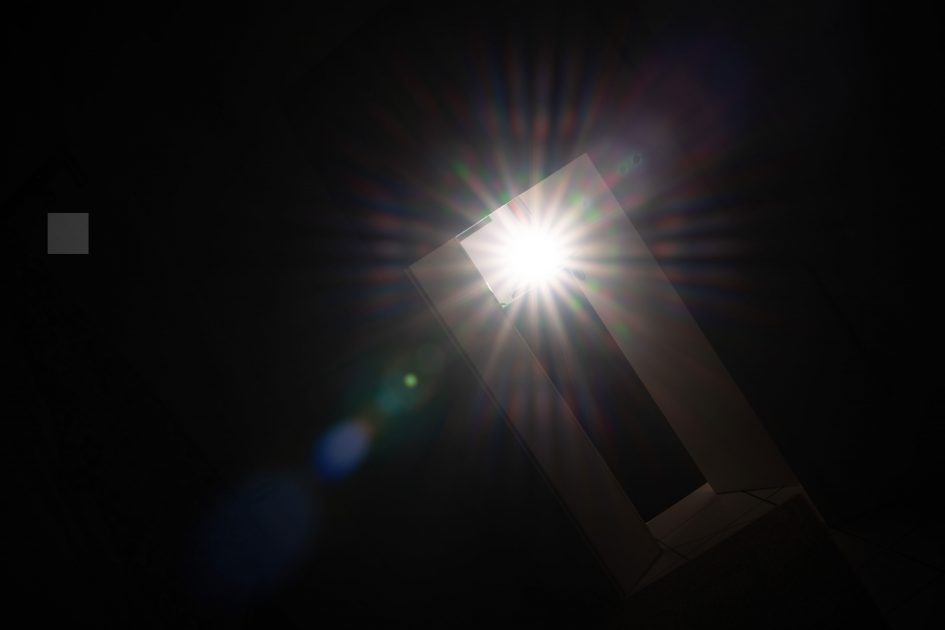
Above: Flare and ghosting. Strong light hitting the Nikon Z 50mm f1.8 S at f11, 4 sec
Flare and ghosting is well controlled as is glare although not as good as from the Nikon Z 35mm f1.8 S (see here). The little square inset on the left of the image shows the respective area with an exposure compensation of +3 EV to make it easier to see which levels of black the lens renders at that point.
The new Z Nikkor is clearly better than the Zeiss Otus in this respect:
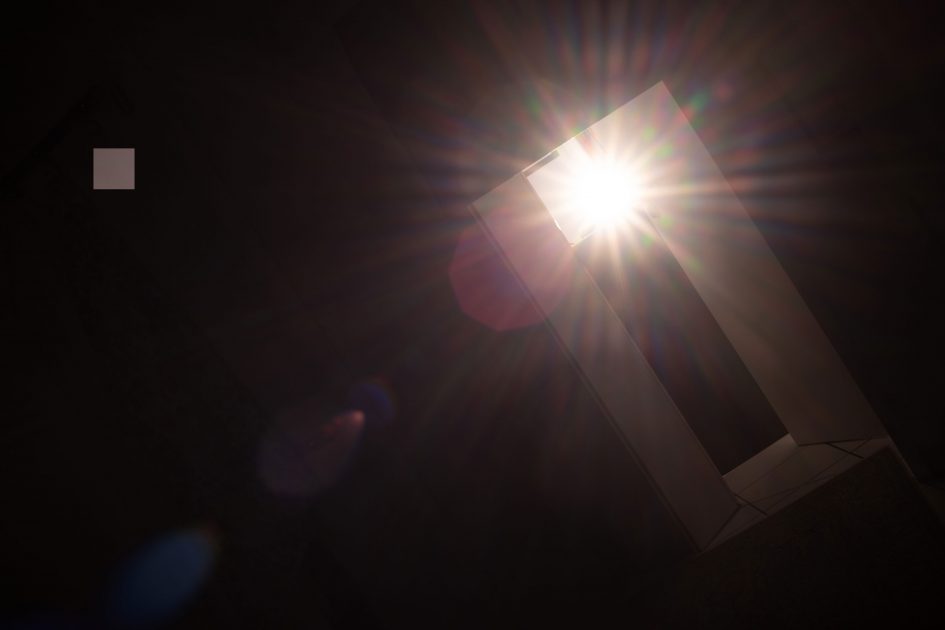
Above: Flare and ghosting. Strong light hitting the Zeiss 55mm f1.4 Otus at f11, 4 sec
When the light-source is just outside the corner the Nikon Z 50mm f1.8 S is less likely to throw a streak of light across the sensor than the other two Z Nikkors or the Zeiss Otus:
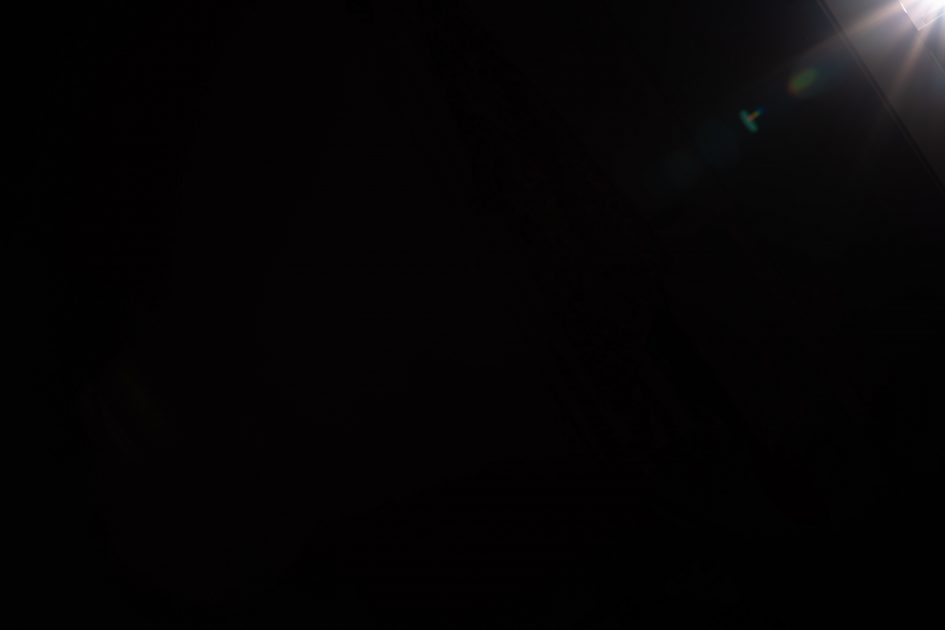
Above: Flare and ghosting. Strong light hitting the Nikon Z 50mm f1.8 S at f11, 4 sec
All-in-all the new Z Nikkor let’s you shoot confidently under adverse contra-light situations. The only drawback being that the Z7 might add some colorful “teardrops” to very bright sunstars as can be seen above. The effect can not always be seen though as the examples below show. To produce nice sunstars the new Nikon Z 50mm f1.8S needs to be stopped down to f8 at least as the spikes/rays are not well defined at f5.6:

Above: Sunstars from the Nikon Z 50mm f1.8 S at f5.6 (left) and f8.0 (right), 100% crops
Next check out my sample images!
Check prices on the Nikon Z 50mm f1.8 S at Amazon, B&H, Adorama, or Wex. Alternatively get yourself a copy of my In Camera book or treat me to a coffee! Thanks!



